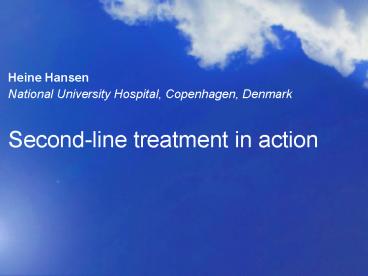Secondline treatment in action - PowerPoint PPT Presentation
1 / 25
Title:
Secondline treatment in action
Description:
Three cycles vinorelbine/carboplatin: no remission. General physical condition considered too poor for. second-line chemotherapy ... Prof Tudor-Eliade Ciuleanu ... – PowerPoint PPT presentation
Number of Views:46
Avg rating:3.0/5.0
Title: Secondline treatment in action
1
Second-line treatment in action
- Heine Hansen
- National University Hospital, Copenhagen, Denmark
2
Case study 1
Case kindly provided by Dr Wolfgang
Schütte Städtisches Krankenhaus Martha-Maria
Halle Dölau, Germany
3
Case study 1
- 78-year-old female, Caucasian, non-smoker PS 2
- Poorly-differentiated adenocarcinoma
- stage T3N2M0 (IIIA)
- Three cycles vinorelbine/carboplatin no
remission - General physical condition considered too poor
for second-line chemotherapy - Treatment with Tarceva 150mg/day was initiated
4
Case study 1 (contd)
Striking tumour response and clinical improvement
How long should treatment be maintained?
Start of treatment PS 2
After 2 months of Tarceva (complete
remission)PS 0
5
Case study 1 (contd)
- Follow-up after 10 months
- Complete remission maintained good PS
- Corroborates use of continued treatment in
absence of disease progression
6
Management of rash
Moderate
Severe
Mild
Grade 3/4 lt9 patients in BR.21 (n731)1 12
patients in TRUST (n2,412)2
- If rash occurs, do not automatically stop Tarceva
- Important to verify proper dosing and
administration
Single-arm, multicentre, phase IV study of
Tarceva 150mg/day in patients with advanced NSCLC
who had failed or were not suitable for
chemotherapy
1Shepherd FA, et al. N Engl J Med
2005353123322Reck M, et al. J Clin Oncol
200624(Suppl. 18)411s (Abs. 7190)
7
Management of rash (contd)
Moderate
Severe
Mild
From start of therapy twice daily application of
alcohol-free emollient cream to entire body, and
sunscreen to exposed skin, may help prevent skin
reactions
8
Management recommendations for symptomatic rash
(assess every 2 weeks)
Moderate
Severe
Mild
No treatment
Hydrocortisone12 cream OR Clindamycin gel or
cream, if infected
Treat as moderate
OR
AND
Hydrocortisone12 cream
Systemic steroids
AND
AND
Synthetictetracycline
Consider dose interruption
Doxycycline 100mg b.i.d. Prednisone,
methylprednisolone 30mg once daily (tapered over
30 days)
9
Case study 1 (contd)
- Grade 3 rash occurred
- Dose reduced to 100mg after 3 weeks on therapy
- Dose reduced to 50mg after a further month
- Complete remission of rash after 4 weeks
- dose increased to 100mg
- In the TRUST study of Tarceva 150mg/day
(n2,041), dose reductions due to
erlotinib-related rash were necessary in only 8
of patients1
1Reck M, et al. J Clin Oncol 200624(Suppl.
18)411s (Abs. 7190)
10
Case study 2
Case kindly provided by Prof Jean-Charles
SoriaInstitut Gustave Roussy, Villejuif, France
11
Case study 2
- 61-year-old female, Caucasian, never-smoker PS 1
- October 2004 lung adenocarcinoma
- stage T2N0M1 (IV)
- brain metastases
12
Case study 2 (contd)
- Total brain radiotherapy (10 sessions), followed
by five cycles of cisplatin vinorelbine - Chemotherapy discontinued due to grade 3 anorexia
and deterioration in PS - Partial response in lung and brain (March 2005)
- June 2006 progression in lung
- confusion, secondary to carcinomatous
leptomeningitis
13
Case study 2 (contd)
- Patient received high-dose steroids
- slight improvement
- Treatment initiated with Tarceva 150mg/day
- confusion improved within 72 hours
- disappearance of carcinomatous cells in
cerebrospinal fluid
14
Case study 2 (contd)
Before treatment
After 9 weeks of Tarceva
15
Case study 2 (contd)
Before treatment
After 9 weeks of Tarceva
16
Case study 2 (contd)
- December 2006 progressive disease (PD), new
medullary lesions - January 2007 confusion increase of medullary
lesions - Tarceva 300mg/day ? no improvement
- Reappearance of carcinomatous cells in
cerebrospinal fluid - Rapid global status degradation
- Treatment stopped BSC
17
Small retrospective case series of EGFR TKIs in
patients with brain metastases
Hotta K, et al. Lung Cancer 20044625561Chiu
C-H, et al. Lung Cancer 20054712938
18
Ongoing studies of Tarceva in patients with brain
metastases
SRS somatostatin receptor scintigraphy WBRT
whole brain radiotherapy
Source www.cancer.gov
19
Case study 3
- Case kindly provided by
- Prof Tudor-Eliade Ciuleanu
- Cancer Institute Ion Chiricuta, and University of
Medicine and Pharmacy Iuliu Hatieganu,
Cluj-Napoca, Romania
20
Case study 3
- 53-year-old female 15 cigarettes/day for 23
years PS 1 - Right lower lobe tumour (CT scan 78cm) with
carinal invasion - Multiple enlarged mediastinal lymph nodes
(11.5cm) - Adenocarcinoma (bronchoscopy)
- stage T4N2M0 (IIIB)
21
Case study 3 (contd)
- Three cycles of etoposide cisplatin, followed
by RT(30 Gy/10 fractions for 12 days) ? SD - PD after 4 months tumour size 12cm PS worsened
(PS 2) - ? severity of cough, dyspnoea, pain, haemoptysis
- Chemotherapy discontinued
22
Case study 3 (contd)
- Patient requested a trial with Tarceva (entered
into BR.21 study) - Tarceva 150mg/day initiated
- Cough and pain improved (grade 2?1) haemoptysis
resolved fatigue remained stable - Self-rated QoL was stable, as was performance
status (PS 2) - Grade 1 stomatitis (resolved spontaneously after
2 months) - Mild (grade 1) facial rash throughout treatment
no discomfort
23
Case study 3 (contd)
- Best response was SD maintained for 6 months
during continuous treatment with Tarceva - After 6 months a CT scan showed PD and Tarceva
was discontinued - 3 months later, the patient agreed to receive
three cycles of docetaxel 75mg/m2 every 3 weeks ?
SD - Subsequently remained stable and survived gt3
years after starting Tarceva
24
Radiographic response to Tarceva is not required
to obtain a survival benefit (BR.21)
Months
OSI Pharmaceuticals and Roche data on file
25
Key learnings
- Tumour response is not essential to benefit from
Tarceva - Tarceva has a favourable tolerability profile
versus chemotherapy - rash is easily managed and does not usually
affect patients daily lives - Tarceva produces important symptom and QoL
benefits - Tarceva may have a role in the treatment of
patients with central nervous system metastases































